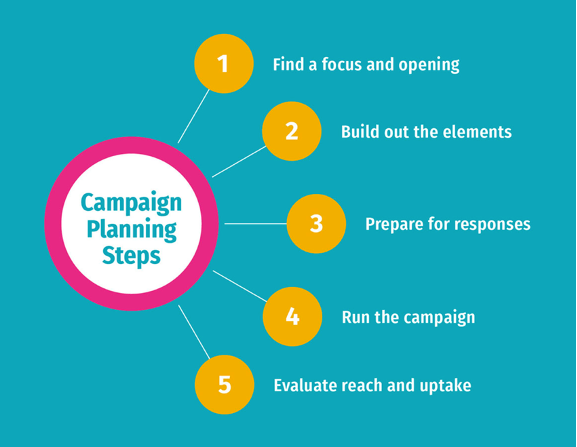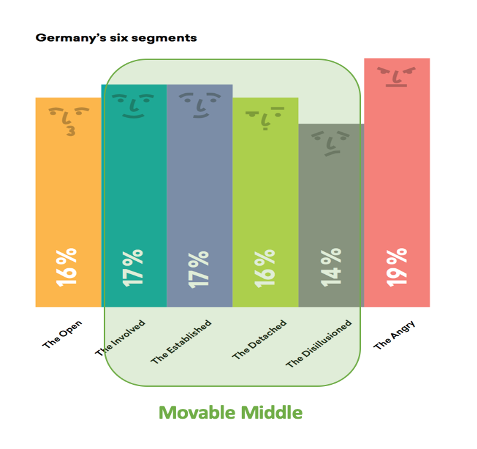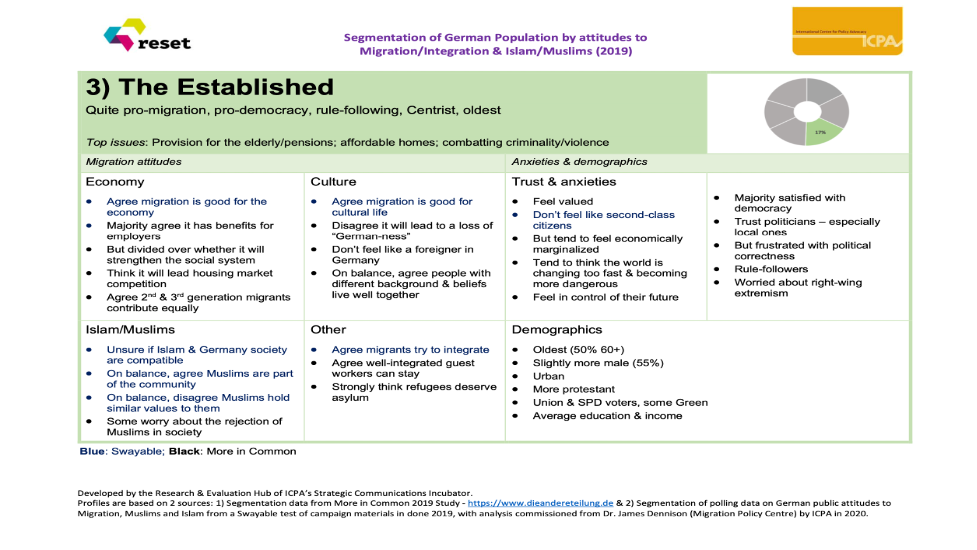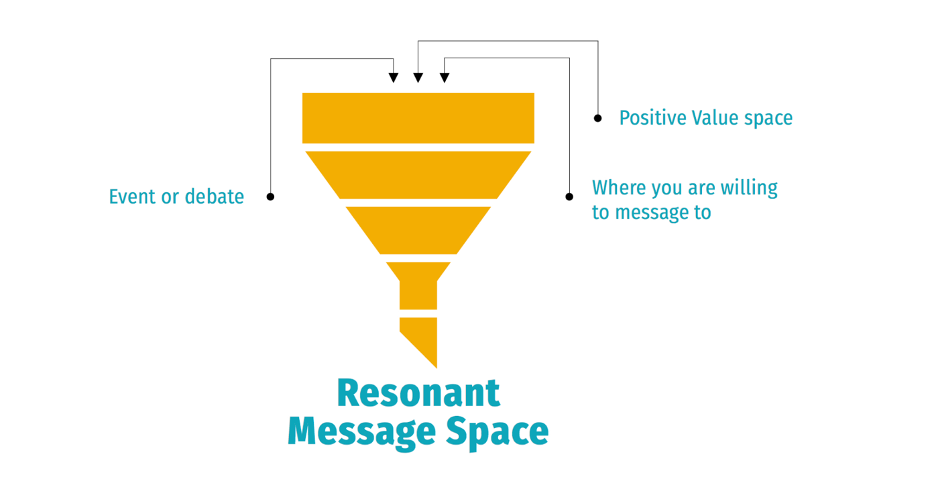Chapter 4-2 The #KommMit strategy & messaging
4.3 The strategy development process
An essential focus of the RESET project and the New Narratives Lab was supporting the CLAIM network to build their capacity to constructively and effectively engage middle audiences in the polarised debates around Muslims and more broadly around migration and integration. A values-based approach is at the core of engaging the middle, and this entails finding a unifying value appeal as a bridge to both reduce anxiety and reinforce any existing support on the issue. This in turn, opens the space for a constructive social-cohesion-framed debate [See chapter 2 for a more in-depth explanation].
The strategy development process for the #KommMit pilot followed the first three steps outlined in ICPA’s Narrative Change Campaign Planning process (see Figure 11 below) and more specifically, followed the following process:
- Choose a target segment(s)/audience
- Develop a unifying value appeal and set of messages
- Develop a pitch and draft stories
- Test and get feedback on the messages and draft stories

Figure 11: ICPA’s Narrative Change Campaign Planning Process
4.3.1 Choosing the target audience/segment
CLAIM members, led by the six-person working group, chose to focus on one middle segment called ‘The Established’3
. The foundation to make an informed choice of a target audience starts from an evidence base that helps understand who the movable middle are, their current attitudes and also more broadly, the current shape of the public debate.
Start by understanding the middle and the current debate
As detailed in chapter 2, extensive polling and segmentation of public attitudes throughout Europe over the last decade shows that while there are always segments of strong supporters and opponents, the majority of the public lie in the ‘movable’ middle segments4 on the issue of migration, and this is also the case in Germany (See Figure 12):

Figure 12: The movable middle in Germany (adapted from research by More in Common 20195 )
The starting point was to dig into this research on the segments conducted by More in Common and the set of more targeted short segment profiles we developed for the middle segments6 for the project, building on that research (see Figure 13):

Figure 13: An example of the target middle segment profiles (ICPA 2021)
In order to better understand the scale of the challenge, we also developed a map of the dominant frames in the current debate on migration, integration and Muslims, based on a commissioned internet scraping of German social media that analysed data collected over a year from October 2019 to October 20207
. The frame map provides a holistic picture of an overall state of the debate at the start of the project breaking them down into the dominant frames and narratives, as synopsised in the table below:
| 1. Parallel Society – Migrants are depicted as making little effort, so integration plans fail, leading to divided communities. | 2. Us v them – Islam is said not to fit with German cultural norms and to be an ongoing threat to democracy, gender rights, and secularism. |
|
Lines most often used in the frame:
|
Lines most often used in the frame:
|
| 3. Openness – There is a belief that citizens have an obligation to support populations in trouble by allowing them to come to Germany and assisting in their effective integration. | 4. Instability – New waves of migration are said to overwhelm the system, causing a loss of order and the spread of crime and extremism. |
|
Lines most often used in the frame:
|
Lines most often used in the frame:
|
| 5. Diversity – Multiculturalism is considered as strengthening society, and migrant communities under threat need protection from extremism. | 6. Deprivation - Migrants are considered to be a burden on the economy and welfare systems, taking precious resources from the ‘real’ people. |
|
Lines most often used in the frame:
|
Lines most often used in the frame:
|
| 7. Pragmatism – Migration is considered essential to supporting our future economic and welfare plans. | |
|
Lines most often used in the frame:
|
Table 5: Overview of the main frames in the German debate on migration and Muslims (ICPA 2021)
To move beyond the idea of middle groups as research subjects, the working group also personified a typical member of the each of the middle segments. They tried to think of people they knew who may be a member of the segments (e.g. neighbours, family members), role played them and even drew them. All of this served as a way of humanising the segment and their anxieties and motivations. For example, Bernhard was the typical example of ‘The Established’ drawn by the group:

Figure 14: Personification of a member of ‘The Established’
Digging into the research gives advocates a better idea of where the challenges lie, and also of the opportunities. Taking the segmentation research to the personification level also allows campaigners to look in a deeper way at those they think they can engage and the possible openings for the chosen groups.
- RESET Frame Map – ICPA (2020) Frame Map of the Debate on Migration/Integration & Islam/Muslims in Germany (Oct 2019-October 2020)
- RESET Segments – ICPA (2020) Segmentation of German Population on attitudes to Migration/Integration & Islam/Muslims
- Original Segmentation Research - More in Common (2019) Die andere deutsche Teilung: Zustand und Zukunftsfähigkeit unserer Gesellschaft (More in Common has also provided various updates on the attitudes of these segments since 20198 ).
Choosing ‘The Established’
After considering the segments and the broader debate, the working group decided that it would be too difficult to move the attitudes of ‘The Disillusioned’ and that ‘The Involved’ would not be enough of a challenge for this pilot. The group also considered targeting ‘The Detached’, but once they started to dig further into trying to build a single pilot strategy for ‘The Detached’ and ‘’The Established’, it became clear that this would be too challenging. Hence, in the end, they decided to focus solely on ‘The Established’ for the following reasons:
- ‘The Established’ are rather positive on migration, but less so about Muslims. So, the challenge was important, but it was promising that a foundation of support already existed to build on.
- They are big community participators, joining clubs and associations, and hence, can be influential. In fact, many NGOs in the #KommMit strategy development group recognised this profile from stakeholders in their own communities and so, the working group were confident they could find common ground with this segment.
- As an older group of mostly parents and grandparents, they can be opinion leaders in their families and communities. Also, a very high proportion of them will vote at every opportunity.
- They are not the lowest hanging fruit in the movable middle; so, if the #KommMit pilot could move their attitudes in the positive direction, this shows potential for follow-up work on further segments.
The segment represents a relatively small proportion of the German population (17%), but for all the reasons listed above, they are likely to have an outsized level of influence especially at community level. Hence, they were a solid choice for the pilot.
Have a look at the frame map and the attitude segmentation study as a starting point in considering the movable middle as your target audience.
- Have you experience engaging any of the four middle segments? How was this experience?
- Who do you know (for example, a relative, friend, colleague) that you think fits each of the four middle segments? Describe them.
- Would you be more interested to engage the ‘softer end’ of the middle (the ones closest to more open attitudes) or the ‘harder end’ (those closest to the extreme opposition)?
- Which criteria are important in making your choice?
4.3.2 Deciding on the value appeals
We used two tools to support the working group to arrive at value appeals for the #KommMit pilot. The most important was the funnelling of key elements to come to a strategic decision on a messaging approach. This is a key step we developed as part of ICPA’s Reframing Migration Narratives Toolkit. The second tool draws on the work of the leading narrative strategist, Anat Shenker-Osorio9
.
Tool 1: Funnelling to a resonant and unifying value appeal
We use the following funnelling tool to support groups in identifying a resonant overlapping or unifying value space for their narrative change campaign:

Figure 15: Elements of funnelling to a resonant and unifying value appeal
The elements needed in order to come to a decision are:
- A positive value map for your target segment – this is a process of elaborating the values your target group would argue they are defending and promoting in their position in the debate. This is not your analysis of their position, but rather what you would assume is their analysis of their position. For example, through this process, the working group identified that ‘The Established’ would say they are protecting and promoting the values of productivity and professionalism, stability, social cohesion, compassion, knowledge and community pride.
- An event or debate you are targeting – when trying to engage middle groups, it is a good idea to choose a debate or event that you know will attract your target audience. This gives you a chance to engage them directly in a shared challenge or celebration, e.g. another campaign group we supported in Germany focused on engaging a middle segment chose the Day of German Unity, as an event to target and as a means to reframe the idea of unity. As #KommMit was a pilot focused on experimenting and testing rather than larger-scale campaigning, this was a specific decision that the working group didn’t need to make. But leveraging a suitable existing opportunity could present interesting opportunities for scaling up #KommMit in the future.
- Where you are willing to message to? – looking at the positive value map, you need to find an event or debate and value appeal that also works for you as advocates. This is key in order for you to authentically engage the audience. From the values elaborated through the positive value mapping, the working group for the #KommMit pilot decided they were willing to message on values of interdependence, stability, fairness and shared future, but not on values of economic performance and utility of migrant workers.
See more on the steps in this process in our Reframing Migration Narratives Toolkit, especially the step by step worksheet to guide the positive value mapping exercise.
Tool 2: Work from problem/issue to values
The second tool we used to support the team in coming to the decision on a messaging strategy entails a process of writing down the specific problems or issues you face, and then trying to identify the values associated with these issues that might be useful to use in engaging the target audience. This is an approach developed by Anat Shenker-Osorio10
and she elaborates the approach with the example that the LGBTQ+ movement in many countries won once it moved away from a discussion of specific rights in public campaigning and embraced the values of family and commitment. The table below provides four examples the working group used in the strategy development process for #KommMit:
| Replace Problems | Embrace Values |
| 1. Dichotomous thinking between "them" and "us" (Muslims/non-Muslims/white-non-white) | We are all part of a society. Let's develop society together and shape it according to our shared values. (Values: Responsibility/ participation/future) |
| 2. Muslims (and other marginalised groups) are often not granted the same rights (claiming rights, freedom of expression, freedom of religion, self-determination rights) | When we respect each other's (human) rights, we feel safer and more valued. (Values: justice/stability) |
| 3. People are excluded on the basis of arbitrarily chosen characteristics, which is contrary to our democratic value. | For a truly democratic society, it is essential that we all treat each other with respect at all times. (Values: interdependence/ justice/stability) |
| 4. Muslim (read) people are often seen as a homogeneous group. Problems of individuals are often simplified and generally attributed to "Islam" and "Muslims" | We want to be recognised as individuals and have our personal needs and interests seen and valued. We don't want to be judged across the board. (Values: Justice/Fairness) |
Table 6: Examples of replacing problems and embracing values from the #KommMit strategy development process
Following a back and forth using these two tools, the working group landed on the set the value appeals for the pilot listed in Figure 1 in the opening of the chapter, which can be summarised as:
- Interdependence/solidarity,
- Participation,
- Stability and security
- Intergenerational future.
Try out the funnelling tool and the positive value mapping exercise on one of the middle segments you’re interested in targeting. Then answer the following questions:
- What are the positive values of your target segments that you would be willing to build a message on?
- What are the positive values of your target segments that you would not be willing to build a message on?
- Can you think of an event or specific current debate you could target that also mobilises the segment you focused on?
- How did you feel during the process using these two tools?
<-- Chapter 4-1 | Chapter 4-3 -->
- 3More in Common (2019) Die andere deutsche Teilung: Zustand und Zukunftsfähigkeit unserer Gesellschaft.
- 4https://www.moreincommon.com/our-work/research/
- 5More in Common (2019) Die andere deutsche Teilung: Zustand und Zukunftsfähigkeit unserer Gesellschaft.
- 6See short descriptions of the segments developed by ICPA (2021) RESET Segments. In these descriptions, we built on the More in Common 2019 work and also added more in-depth attitudes on Muslims and Islam.
- 7ICPA (2021) RESET Frame Map Based on internet scraping commissioned from Bakamo Social).
- 8More in Common (2021) Vertrauen, Demokratie, Zusammenhalt: wie unterschiedlich Menschen in Deutschland die Corona-Pandemie erleben; More in Common (2021) Zusammenhalt in der Einwanderungs-gesellschaft: Wie die sechs gesellschaftlichen Typen über Migration denken; More in Common (2021) Begegnung und Zusammenhalt: Wo und wie Zivilgesellschaft wirken kann; More in Common & Robert Bosch Stiftung (2021) Itʼs Complicated. People and Their Democracy in Germany, France, Britain, Poland, and the United States; More in Common (2023) Zukunft, Demokratie, Miteinander: Was die deutsche Gesellschaft nach einem Jahr Preiskrise umtreibt.
- 9Centre for Community Change (2020) Messaging This Moment. Lesson 1: Lead with shared values, not problems.
- 10Centre for Community Change (2020) Messaging This Moment. Lesson 1: Lead with shared values, not problems.